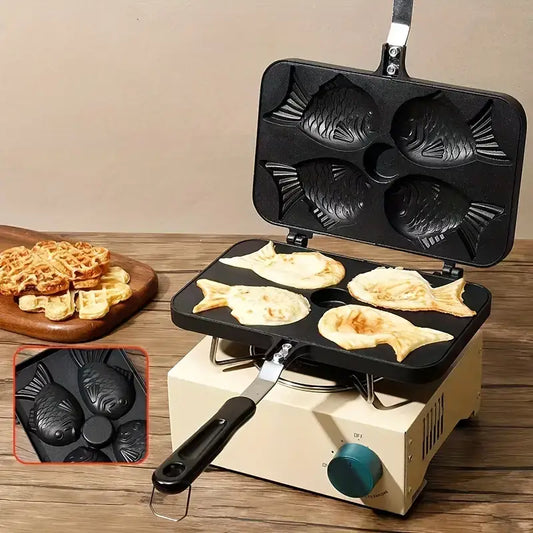🐟✨ Taiyaki Pans: Casting Culture, Comfort, and Crispy Nostalgia in Iron 🔥🥞🍡
The sizzle is unmistakable — a whisper of batter meeting hot metal, followed by the sweet aroma of caramelizing flour and azuki beans. A street vendor flips a cast iron mold, and out emerges a golden fish, plump with filling and crisp at the fins.
This is Taiyaki — the beloved fish-shaped treat of Japan. And behind every perfect Taiyaki lies its heart and hearth: the Taiyaki pan, or Taiyaki-ki (鯛焼き器) 🐟🍳🫧
More than just a cooking tool, the Taiyaki pan is a culinary icon, a vessel of nostalgia, craftsmanship, and street-side ritual. It’s cast in tradition, glazed with joy, and flips not just batter — but stories, history, and emotion 💫📜
So let’s heat up the griddle and explore the world of Taiyaki pans — from their Meiji-era birth to their modern-day magic, from cast iron artistry to Instagrammable desserts. This is the tale of the pan that brings the fish to life 🐟🔥✨
📜 Origins: A Fish Born of Fire and Folklore 🧧🎐
The Taiyaki itself has roots that go back to the Meiji period (1868–1912) — an era of modernization, Western influence, and culinary innovation.
Originally inspired by Imagawayaki (a round, filled cake), the fish shape was introduced by a sweets maker named Seijirō Kanbei, who wanted to make his pastry stand out. He chose the tai (sea bream) — a fish long associated with good luck, celebration, and prosperity in Japanese culture 🐟🎊
Tai is especially prized during:
- New Year’s feasts (osechi-ryōri)
- Weddings and births
- Festivals honoring good fortune and bountiful harvests
Its very name is a lucky pun: “medetai” (auspicious) ✨🍱🐟
And so, the Taiyaki pan was born — crafted to imprint every crisp edge of this lucky fish onto warm, pillowy batter.
🧱 Anatomy of a Taiyaki Pan: Form Meets Flavor 🐟🍳
A Taiyaki pan is simple in design but deeply thoughtful in execution.
🧯 1. Material: Cast Iron & Aluminum
- Traditional Taiyaki pans are made from cast iron — perfect for even heat retention, deep browning, and flavor development 🔥⚖️
- Some modern home-use versions are made with aluminum with nonstick coatings — lighter, easier to handle, but with less crust magic
🐟 2. Shape: Molded to Myth
Each pan features two halves of a fish-shaped mold:
- One side for the belly (where filling is spooned in)
- The other for the back (pressed down to seal and shape)
The molds capture fine details:
- Scales
- Eyes
- Tail fins
- Gills and mouths — all textured for maximum crisp ✨🎨
🔁 3. Hinge or Flip System
- Street vendors often use large hinged pans with multiple molds — flipping the entire tray at once like a fiery page-turner
- Home pans usually feature double-sided griddles or press-style handles, flipped manually over stovetop heat
The design may look playful, but its purpose is culinary precision: even fill, perfect seal, no leak, crispy edge, golden hue 🧪🍯
🍡 The Ritual: How Taiyaki Is Made, One Flip at a Time 🔁🍳
Making Taiyaki is part technique, part rhythm — a little culinary dance that transforms batter and filling into edible art.
Here’s the traditional sequence:
- Oil the mold — brushed lightly for that glossy finish 🧴✨
- Ladle in the batter — enough to coat the bottom, but not flood
-
Spoon in the filling — typically anko (sweet red bean paste), but now includes:
- Custard 🍮
- Chocolate 🍫
- Matcha cream 🍵
- Cheese 🧀
- Sweet potato 🍠
- Top with more batter — to seal the fish shut
- Close the pan — press gently, edges aligned
- Flip periodically — over the fire or stovetop, to ensure golden brown scales on both sides 🐟🔥
Cook time? About 3–5 minutes — just long enough for the outside to crisp and the inside to steam.
The final step? Crack open the pan and reveal the fish — a puffed-up, smiling, golden treat that’s almost too cute to eat... almost 😋💕
🎊 From Yatai to You: Taiyaki Pans in Japanese Street Food Culture 🏮🍢
In Japan, Taiyaki is a festival staple — found at:
- Shrine matsuri (festivals) 🏮
- New Year’s events 🎍
- Hanami picnics beneath cherry blossoms 🌸
- Autumn night markets under glowing lanterns 🍁🌕
Vendors wield giant Taiyaki pans like culinary katanas — flipping with flair, ladling batter with practiced precision, and serving up hot fish in wax paper sleeves to kids, couples, and tourists.
Each stall has its signature twist:
- Some add custard & chocolate hybrids
- Others serve mini Taiyaki by the dozen
- A few make “croissant Taiyaki” with puff pastry and almond flakes 🥐✨
But always — the Taiyaki pan is the star: sizzling, flipping, crisping, enchanting 🍳✨🐟
🍵 Home-Use Taiyaki Pans: Nostalgia on Your Stovetop 🏠🧁
Thanks to the global love for Japanese sweets, Taiyaki pans are now widely available for home cooks — in designs that are:
- Compact (usually 2–4 fish molds)
- Nonstick or traditional cast iron
- Gas stove or electric griddle compatible
- Some even electric plug-in models for convenience 🔌🎛️
These pans bring the joy of Taiyaki into:
- Sunday brunch with matcha mochi filling 🍵
- After-school snacks with Nutella & banana 🍌🍫
- Cozy rainy-day baking with apple cinnamon or pumpkin spice 🍎🍂
Making Taiyaki at home is a ritual of warmth and fun, especially with kids — from pouring the batter to watching the golden fish emerge, tail-first, from the heat 🐟💫
🧵 Design Aesthetics: From Traditional Charm to Modern Kawaii 🎨🐟
Taiyaki pans — like the sweets they birth — reflect Japanese design values:
- Attention to detail: Every fin, eye, and scale matters 🖌️
- Balance of form & function: Art you can cook with 🎐
- Cultural playfulness: Combining tradition with cuteness 🤗
Modern variations include:
- Mini Taiyaki molds (bite-sized cuteness 🐟💖)
- Heart-shaped Taiyaki pans for Valentine’s fusion treats 💘
- Double-sided “croissant Taiyaki” molds with deeper cavities and flakier potential 🥐
Even anime cafés and pop-ups have gotten involved — printing characters like Hello Kitty or Totoro into special pans 🍥🐱🌲
🧬 Symbolism in the Shape: Why Fish? Why Tai? 🎏💫
The sea bream, or tai, isn’t just random. In Japanese culture, it’s an emblem of:
- 🧧 Good fortune and abundance
- 🎊 Festivity and celebration
- 🌊 Resilience and perseverance
- 🐉 Even a spiritual link to dragons and sea deities
The wordplay of tai (sea bream) and medetai (auspicious) is key — it’s believed that eating tai-shaped sweets invites good luck, especially during life milestones or seasonal shifts 🕊️🌸🎓
So, every Taiyaki pan is more than a mold — it’s a fortune-caster, a celebratory talisman disguised as street food 🎴🐟✨
🌐 Global Taiyaki Craze: A Pan That Crossed Borders ✈️🍩
Taiyaki’s charm didn’t stay in Japan — it swam across the world and reinvented itself:
- In Korea: as bungeoppang, with similar fish molds but Korean fillings like sweet corn or red bean paste
- In the U.S.: Taiyaki became an Instagram darling, especially when used for ice cream cones — a fish with a scoop of matcha soft-serve, topped with mochi, sprinkles, and edible flowers 🍦🌸
- In Europe: Taiyaki pans are used for savory fillings like smoked salmon & cream cheese or even pizza-style Taiyaki 🍕🐟🧀
And everywhere they go, Taiyaki pans remain conversation pieces — tools that transform kitchens into kawaii cafés 🌟🏠🍰
💭 Final Flip: What Taiyaki Pans Really Represent 🍳🐟🌸
To hold a Taiyaki pan is to hold:
- A slice of cultural memory
- A street corner from Tokyo
- A lucky fish you bake at home
It is a tool of:
- Craftsmanship 🛠️
- Playfulness 🐟
- Nostalgia 🕰️
- Celebration 🎊
And perhaps most beautifully — the Taiyaki pan turns the act of feeding into a form of giving. A golden fish, handed fresh from the iron, says:
“I made this for you.”
“May it be sweet, may it bring luck.”
“And may the moment stay warm forever.”
So heat the pan. Pour the batter. Spoon the filling. Flip with love.
And watch the lucky fish swim from the flames into your heart 🐟🔥💖











